Zimhi
Generic name: naloxone hydrochloride
Dosage form: injection
Medically reviewed by A Ras MD.
What is Zimhi?
Zimhi is a prescription medicine used in adults and children for the treatment of an opioid emergency such as an overdose or a possible opioid overdose with signs of breathing problems and severe sleepiness or not being able to respond.
Zimhi is to be given right away and does not take the place of emergency medical care. Get emergency medical help right away after the first dose of Zimhi, even if the person wakes up. Zimhi is safe and effective in children for known or suspected opioid overdose.
Description
ZIMHI (naloxone hydrochloride injection, USP) is an opioid antagonist supplied in a single-dose pre-filled syringe. ZIMHI is not made with natural rubber latex. Chemically, naloxone hydrochloride is the hydrochloride salt of 17-Allyl-4,5α-epoxy-3,14- dihydroxymorphinan-6-one hydrochloride with the following structure:
 |
| C19H21NO4∙ HCl |
| 363.8 g/mol |
Naloxone hydrochloride occurs as a white to slightly off-white powder, and is soluble in water, in dilute acids, and in strong alkali; slightly soluble in alcohol; practically insoluble in ether and in chloroform.
Each 0.5 mL contains 5 mg naloxone hydrochloride (equivalent to 4.5 mg naloxone), 4.17 mg sodium chloride, hydrochloric acid to adjust pH, and water for injection.
Mechanism of Action
Naloxone hydrochloride is an opioid antagonist that antagonizes opioid effects by competing for the same receptor sites.
Naloxone hydrochloride reverses the effects of opioids, including respiratory depression, sedation, and hypotension. Also, it can reverse the psychotomimetic and dysphoric effects of agonist-antagonists such as pentazocine.
What is the most important information I should know about Zimhi?
Zimhi is used to temporarily reverse the effects of opioid medicines. The medicine in Zimhi has no effect in people who are not taking opioid medicines. Always carry Zimhi with you in case of an opioid emergency.
- Use Zimhi right away if you or your caregiver think signs or symptoms of an opioid emergency are present, even if you are not sure, because an opioid emergency can cause severe injury or death. Signs and symptoms of an opioid emergency may include:
- unusual sleepiness and you are not able to awaken the person with a loud voice or rubbing firmly on the middle of their chest (sternum)
- breathing problems including slow or shallow breathing in someone difficult to awaken or they look like they are not breathing
- the black circle in the center of the colored part of the eye (pupil) is very small, sometimes called “pinpoint pupils” in someone difficult to awaken
- Family members, caregivers, or other people who may have to use Zimhi in an opioid emergency should know where Zimhi is stored and how to give Zimhi before an opioid emergency happens. Make sure everyone reads the information contained in the case and carton as soon as you receive Zimhi.
- Zimhi is intended to be given by people 12 years of age or older. Younger children or those with limited hand strength may find the Prefilled syringe difficult to use.
- Get emergency medical help right away after using the first dose of Zimhi. Rescue breathing or CPR (cardiopulmonary resuscitation) may be given while waiting for emergency medical help.
- The signs and symptoms of an opioid emergency can return after Zimhi is given. If this happens, give additional injections using a new Zimhi prefilled syringe every 2 to 3 minutes and watch the person closely until emergency help is received.
Who should not use Zimhi?
Do not use Zimhi if you are allergic to naloxone hydrochloride or any of the ingredients in Zimhi. See the end of this leaflet for a complete list of ingredients in Zimhi.
What should I tell my healthcare provider before using Zimhi?
Before using Zimhi, tell your healthcare provider about all of your medical conditions, including if you:
- have heart problems
- are pregnant or plan to become pregnant. Use of Zimhi may cause withdrawal symptoms in your unborn baby. Your unborn baby should be examined by a healthcare provider right away after you use Zimhi.
- are breastfeeding or plan to breastfeed. It is not known if Zimhi passes into your breast milk.
Tell your healthcare provider about the medicines you take, including prescription and over-the-counter medicines, vitamins, and herbal supplements.
How should I use Zimhi?
Read the “Instructions for Use” at the end of this Patient Information leaflet for detailed information about the right way to use Zimhi.
- Use Zimhi exactly as prescribed by your healthcare provider.
- Each Zimhi Prefilled syringe contains only 1 dose of medicine and cannot be reused.
- Zimhi should be injected into the muscle (intramuscular) or underneath the skin (subcutaneous) of the outer thigh. It can be injected through your clothing if needed.
- Caregivers should pinch the thigh muscle while injecting Zimhi into a child under the age of 1 year old.
- If an accidental needlestick injury occurs, get emergency medical help right away. Accidental needlestick injuries may put you at risk for blood borne diseases (such as HIV, HBV, and HCV) that can cause illness or death. In addition, report an accidental needlestick injury or problems with the Zimhi Prefilled syringe to Adamis Pharmacovigilance at (800) 230-3935.
What are the possible side effects of Zimhi?
Zimhi may cause serious side effects, including:
- Sudden opioid withdrawal symptoms. In someone who has been using opioids regularly, opioid withdrawal symptoms can happen suddenly after receiving Zimhi and may include:
The most common side effects of Zimhi include: nausea, dizziness, lightheadedness, and increased amounts of red blood cell breakdown products (bilirubin) in your blood.
In infants under 4 weeks old who have been receiving opioids regularly, sudden opioid withdrawal may be life-threatening if not treated the right way. Signs and symptoms include: seizures, crying more than usual and increased reflexes.
These are not all of the possible side effects of Zimhi. Call your doctor for medical advice about side effects. You may report side effects tFDA at 1-800-FDA-1088.
General information about the safe and effective use of Zimhi
Medicines are sometimes prescribed for purposes other than those listed in a Patient Information leaflet. Do not use Zimhi for a condition for which it was not prescribed. You can ask your pharmacist or healthcare provider for information about Zimhi that is written for health professionals.
How should I store Zimhi?
- Store at controlled room temperature 68°F to 77°F (20°C to 25°C).
- Excursions between 59°F and 86° F (15°C and 30°C) are allowed.
- Do not refrigerate.
- Protect from light, extreme heat, and freezing.
- To protect from light, store Zimhi in its outer case until ready to use.
- During storage, check Zimhi often through the viewing window of the prefilled syringe. The solution should be clear. If the Zimhi solution is discolored, cloudy, or contains solid particles, replace it with a new Zimhi.
- Your Zimhi has an expiration date. Replace it before the expiration date.
Keep Zimhi and all medicines out of the reach of children.
What are the ingredients in Zimhi?
Active ingredient: naloxone hydrochloride
Inactive ingredients: sodium chloride, hydrochloric acid to adjust pH, and water for injection.
Zimhi is not made with natural rubber latex
For more information about Zimhi prefilled syringe and proper use of the ZIMHI, call 1-800-230-3935 or visit www.ZIMHI.com.
Instructions for use for Zimhi
Zimhi (ZIM-hye)
(naloxone hydrochloride injection)
Prefilled syringe
Use Zimhi for known or suspected opioid overdose in adults and children.
Zimhi is intended to be administered by people 12 years of age or older. Younger children or those with limited hand strength may find the device difficult to use.
Read this Instructions for Use carefully before you use this product.
Before you need to use your Zimhi syringe make sure your healthcare provider shows you the right way to use it. Parents, caregivers, and others who may be in a position to administer Zimhi should also understand how to use it. If you have questions, ask your healthcare provider.
Get ready to use Zimhi
Zimhi works like a standard prefilled syringe.
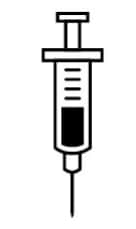
Zimhi is injected downwards, into the middle of the outer thigh, (as shown), through clothing if needed.
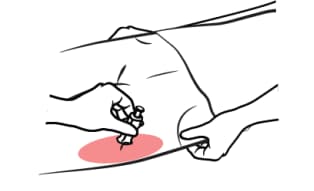
Ready to Use Zimhi
1. Place the patient on their back.
When ready to inject, pull off cap to expose needle.
2. Do not put finger on top of the device.
In children under the age of 1 year old, pinch the thigh muscle while administering the dose
Hold Zimhi by finger grips only and slowly insert the needle into the thigh.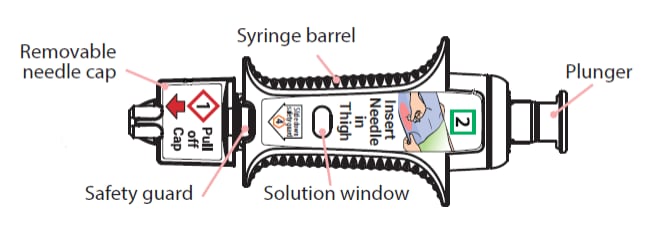
3. After needle is in thigh: Push the plunger all the way down until it clicks and hold for 2 seconds.
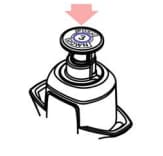
After use
Right after the injection, using one hand with fingers behind the needle, slide the safety guard over the needle. Do not use two hands to activate the safety guard. Put the used syringe into the blue case and close the case.
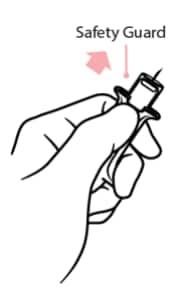
5. Get help
Get emergency medical help now
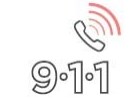
Tell healthcare provider that you gave an injection of naloxone hydrochloride.
Turn the patient on their side (recovery position) after giving Zimhi.
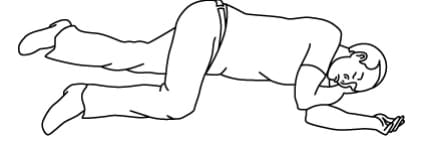
Use second syringe if needed
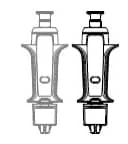
You may need a second Zimhi syringe if symptoms continue or return.
If symptoms return after an injection with Zimhi, an additional injection using another Zimhi prefilled syringe may be needed. Give additional injections using a new Zimhi prefilled syringe every 2 to 3 minutes and continue to closely watch the person until emergency help is received. Using Zimhi does not take the place of emergency medical care.
After use and disposal
- Zimhi is a single-dose prefilled syringe that delivers a fixed dose of naloxone hydrochloride. The prefilled syringe cannot be reused. It is normal for most of the medicine to remain in the syringe after the dose has been injected.
- The correct dose has been injected if the plunger has been pushed all the way down and the solution window is at least partially blocked.
- Tell the healthcare provider that you have received or administered an injection of naloxone hydrochloride. Show the healthcare provider where the injection was administered.
- Give your used Zimhi syringe, contained in the blue case, to the healthcare provider for inspection and proper disposal.
For more information see Patient Information sheet or ask your healthcare provider.
How to store
Keep Zimhi in its plastic case nearby and ready for use at all times.
- Store at controlled room temperature, between 68°F to 77°F (20°C to 25°C). Do not expose to extreme cold or heat. For example, do not store in your vehicle’s glove box and do not store in the refrigerator or freezer.
- Store the Zimhi syringe in its closed plastic case to protect from light.
Check your stored Zimhi often – The solution should be clear when viewed through the window on the device. If the solution is discolored (yellowish or brown color), cloudy or contains particles, replace the Zimhi with a new one.
Your Zimhi has an expiration date — Example YYYY-MM. Replace Zimhi before the last day of expiration month. Dispose of expired Zimhi properly by taking the Zimhi in its case to a healthcare provider or hospital emergency room.
For more information about Zimhi prefilled syringe and proper use of the Zimhi, call 1-800-230-3935 or visit www.Zimhi.com.
Label
PRINCIPAL DISPLAY PANEL – 5 MG SYRINGE CARTON
- NDC #78670-140-02
RX ONLY - ZIMHI™
(naloxone HCl injection, USP)
5 mg / 0.5 mL - FOR INTRAMUSCULAR OR SUBCUTANEOUS USE
- USE FOR OPIOID EMERGENCIES SUCH AS SUSPECTED OVERDOSE
- Contains two syringes –
(5 mg Pre-Filled Single Dose Syringes) - US WorldMeds®
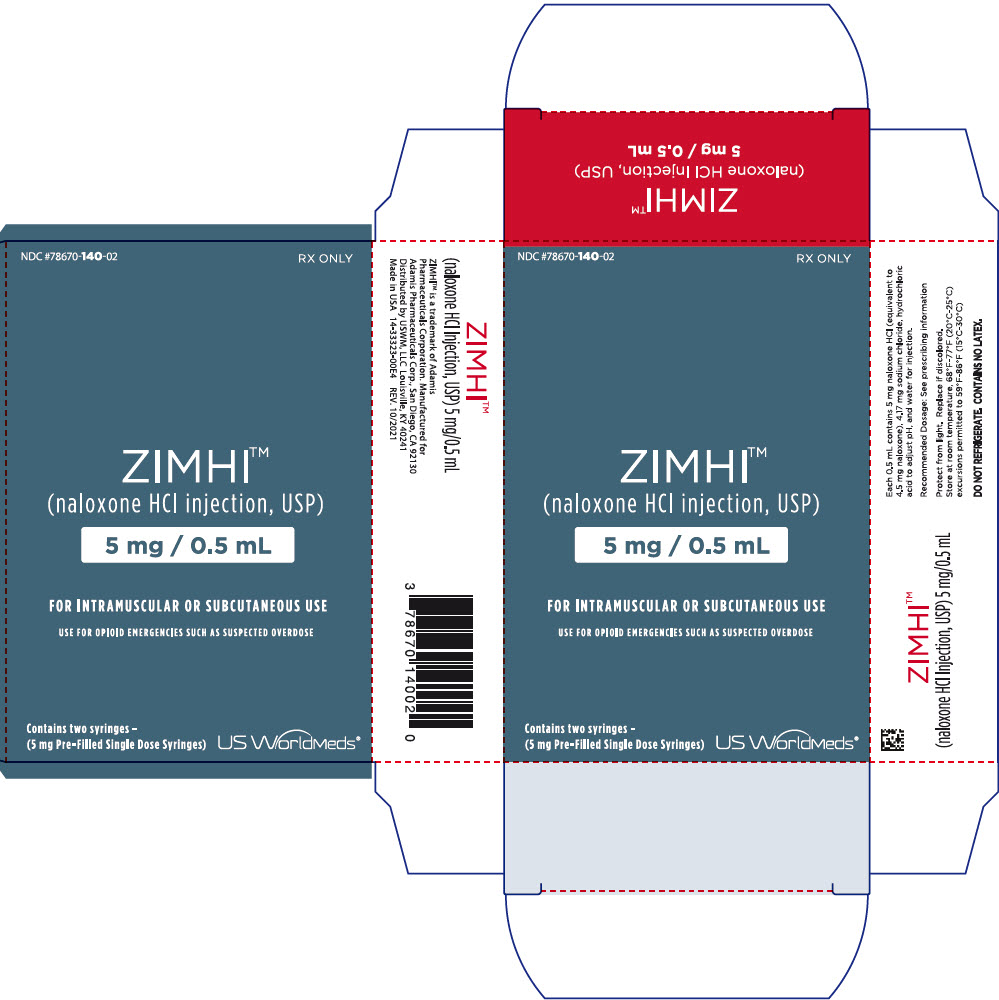
SRC: NLM .
